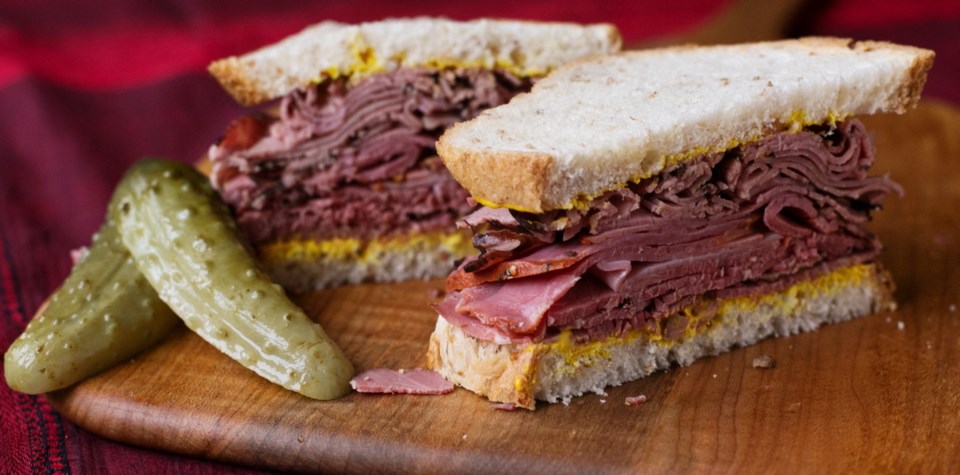Dear Eric: What is the difference between pastrami, corned beef and Montreal smoked meat? They look alike but taste quite different. I am from Montreal and in my opinion, Montreal smoked meat is the only one worthwhile. Is there a store on Vancouver Island where I could get “real deal” Montreal smoked meat? I have tried imitations and been very disappointed.
Lucie
Dear Lucie: Corned beef, pastrami and Montreal smoked meat can look alike because all are made with beef, all are brined and all have a similar interior colour. What makes each distinct is the cut of beef used and how it’s trimmed, how it was brined and with what, and how it is cooked.
In my experience, where you come from and how lovingly prepared the product is often determines which you prefer.
The term “corned” in corned beef dates to the 17th century and refers to the “corns” — i.e. grains — of salt used to cure the meat. It’s made with cuts such as bottom round, cut from the leg, but is more frequently made from brisket. Brisket is a tough cut taken from the front breast section of the animal that requires long, slow cooking to make it deliciously tender.
To make corned beef, the meat is first soaked in a pickle-like brine made with salt, garlic, water and spices, such as bay leaves, peppercorns and cloves. Once brined, the meat is cooked — some processors do that in house, cool it and then sell that ready-to-eat product at deli counters in food stores, where customers often buy it sliced.
Cooked corned beef is also sold in cans, ready to open, eat and serve.
Supermarkets, delicatessens and butcher shops also sell uncooked corned beef, surrounded with the brine, for customers to take home and cook themselves, often by slowly simmering the meat in water until tender. When the meat is almost tender, some will add chunks of vegetables to the pot, such as cabbage, potatoes, carrots and/or other root vegetables, and continue cooking until the meat and vegetables are tender.
Corned beef cooked in this “boiled dinner” is popular in places such as Ireland, the Maritimes and northeastern U.S., where it’s sure to make a fine feast on a cool winter day.
The Oxford Companion to Food says the word pastrami is probably derived through Yiddish from the Armenian or Romanian word pastrama. Pastrama is a term that describes wind-dried, spice-cured beef popular in places such as the Balkans and Mediterranean region, but that process is not used to make the pastrami we enjoy in North America.
The New Food Lover’s Companion describes pastrami as a highly seasoned beef made from well-trimmed cuts such as brisket, round or plate, the latter being the trimmed, boneless portion of the diaphragm muscle. The meat is brined in a mix of ingredients that can include salt, garlic, cracked black peppercorns, red pepper, coriander seeds, cinnamon, cloves and allspice. The pastrami is then smoked, infusing it with more flavour and also cooking it.
In our area, pastrami is available at most food stores, often sold thinly sliced and used to make sandwiches. But if you want to try the best pastrami, many would suggest you go to New York. It’s a city where many delicatessens make their own pastrami that, at the best establishments, has been described as superbly succulent.
Most sources I found described Montreal smoked meat as a type of deli meat made by salting, curing and flavouring beef brisket with spices for several days, a week or longer. The meat is then smoked to cook it and steamed to completion.
According to information on the Quebec government website, gouv.qc.ca, this specialty from Montreal is often associated with New York-style pastrami, which also has European roots. They add that although the two meats go through similar stages of preparation, they taste different, with levels of smokiness and spiciness varying. Different beef cuts are also used: leaner beef plate for pastrami, versus fattier — therefore some would say more flavourful — brisket for Montreal smoked meat.
There’s no room here, but I could write pages more about Montreal smoked meat, listing famed eateries in that city that serve it, including Schwartz’s, and how qualities of the meat can differ from place to place, depending on the brining technique and other factors.
Lucie wanted to know if a store on Vancouver Island sells “real deal” Montreal smoked meat. I took that to mean actually produced in Montreal, but after checking a number of supermarkets, I couldn’t find any. Products labelled smoked meat and Montreal-style smoked meat, made by companies such as Freybe, tastee pretty ordinary and they were not always made with brisket. You can get Dunn’s smoked meat in boil-in-the-bag format at Costco.
I did, however, locate two restaurants that bring in smoked meat from Montreal and turn it into sandwiches and other items. They are Broughton Street Café-Deli (broughtonstreetdeli.com) in Victoria, and La Belle Patate (labellepatate.com) in Esquimalt, a place my son swears by that’s also well known for its poutine.
Lucie, why not give both a try and see if either or both can satisfy your craving for “real deal” Montreal smoked meat?
Note: After recently writing about Yukon Gold potatoes, I was contacted by a 92-year-old gentleman now living in Sidney who should have been mentioned in the article. His name is R.G. Rowberry and he, along with G.R. Johnston, whom I did mention in the story, played a pivotal role in the development of this potato. On behalf of potato lovers everywhere, thank you, Mr. Rowberry, for helping to develop this gem of a spud.
Eric Akis is the author of the just-published hardcover book Everyone Can Cook Everything. His columns appear in the Life section Wednesday and Sunday.
